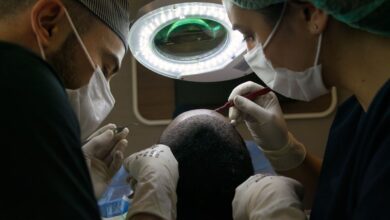Hair Transplant Graft Calculator vs. Manual Calculation: Pros and Cons

Hair transplant procedures have come a long way since their inception in the 1950s. With the advent of new technologies, hair restoration has become more efficient, predictable, and successful. One such technology that has revolutionized hair transplant procedures is the use of graft calculators. These tools help hair transplant surgeons to estimate the number of grafts required for a particular transplant procedure. However, there is an ongoing debate on the efficacy of graft calculators compared to manual calculations. In this article, we will explore the pros and cons of using hair transplant graft calculators compared to manual calculations.
What is a hair transplant graft calculator?
A hair transplant graft calculator is a software tool that helps hair transplant surgeons estimate the number of hair grafts required for a particular hair transplant procedure. Grafts are hair follicles that are extracted from a donor area of the scalp and implanted in the recipient area to restore hair growth. A graft calculator takes into account several factors such as the size of the balding area, hair density, and the patient’s hair characteristics to estimate the number of grafts required.
How does a hair transplant graft calculator work?
A hair transplant graft calculator uses a mathematical algorithm that takes into account several factors to estimate the number of grafts required for a hair transplant procedure. These factors include the size of the balding area, the hair density, and the patient’s hair characteristics such as hair type and colour. The calculator then uses this information to estimate the number of grafts required for the transplant.
Advantages of using a hair transplant graft calculator
Improved accuracy
One of the main advantages of using a hair transplant graft calculator is the improved accuracy it offers. A graft calculator takes into account several factors that can affect the success of a hair transplant procedure. By using a graft calculator, hair transplant surgeons can estimate the number of grafts required with a higher degree of accuracy, leading to a more successful outcome.
Time-saving
Another advantage of using a hair transplant graft calculator is that it saves time. Hair transplant procedures can be time-consuming, and using a graft calculator can help streamline the process. By using a graft calculator, surgeons can estimate the number of grafts required quickly, reducing the time required for the procedure.
Easier planning
Using a hair transplant graft calculator also makes it easier for hair transplant surgeons to plan the procedure. By knowing the number of grafts required beforehand, surgeons can better plan the procedure, ensuring that they have all the necessary resources such as staff and equipment available.
Efficient use of resources
By using a graft calculator, hair transplant surgeons can estimate the number of grafts required accurately, reducing the wastage of resources such as hair follicles. This efficient use of resources can help reduce costs and increase the success rate of the hair transplant procedure.
Disadvantages of using a hair transplant graft calculator
Cost
One of the main disadvantages of using a hair transplant graft calculator is the cost associated with it. Hair transplant graft calculators can be expensive, and not all hair transplant clinics may have access to them. This can limit the number of clinics that offer this technology, making it less accessible to patients.
Reliance on technology
Another disadvantage of using a hair transplant graft calculator is the reliance on technology. If the calculator malfunctions or the data input is incorrect, the estimate for the number of grafts required can be incorrect, leading to an unsuccessful hair transplant procedure.
Limited customization
Hair transplant graft calculators are based on mathematical algorithms that take into account several factors, but they may not take into account the unique characteristics of the patient. For instance, a patient with curly hair may require more grafts than a patient with straight hair. Graft calculators may not take into account such variations, leading to an incorrect estimate of the number of grafts required.
Human error
Hair transplant graft calculators are operated by humans, and there is always the potential for human error. If the data input is incorrect or the calculator is used incorrectly, the estimate for the number of grafts required can be incorrect, leading to an unsuccessful hair transplant procedure.
Manual hair transplant calculation
Manual hair transplant calculation is the traditional method of estimating the number of grafts required for a hair transplant procedure. It involves the hair transplant surgeon manually counting the number of hair follicles in the donor area and estimating the number of grafts required for the recipient area.
Time-consuming
Manual hair transplant calculation can be time-consuming, as it involves manually counting the number of hair follicles. This can increase the time required for the hair transplant procedure.
Subjectivity
Manual hair transplant calculation is subjective and can vary from surgeon to surgeon. Different surgeons may estimate different numbers of grafts required for the same hair transplant procedure, leading to inconsistencies in the outcome of the procedure.
Potential for error
Manual hair transplant calculation is prone to errors, as it involves the manual counting of hair follicles. Human error can lead to an incorrect estimate of the number of grafts required, leading to an unsuccessful hair transplant procedure.
Pros and cons of manual hair transplant calculations
Manual hair transplant calculations have some advantages and disadvantages compared to hair transplant graft calculators.
One advantage of manual hair transplant calculations is that they are less expensive than hair transplant graft calculators. Manual calculations do not require any special equipment or software, making them accessible to more hair transplant clinics.
However, manual calculations can be less accurate than graft calculators, leading to an unsuccessful hair transplant procedure. Manual calculations can also be time-consuming and subjective, leading to inconsistencies in the outcome of the procedure.
Conclusion
Hair transplant graft calculators offer several advantages over manual hair transplant calculations, including improved accuracy, time-saving, and efficient use of resources. However, they have some disadvantages, including cost, reliance on technology, limited customization, and human error.
Manual hair transplant calculations have some advantages, including lower cost and accessibility, but they also have some disadvantages, including lower accuracy and subjectivity.
Ultimately, the choice between hair transplant graft calculators and manual calculations depends on the individual hair transplant surgeon and the patient’s unique hair characteristics. Hair transplant surgeons should weigh the pros and cons of each method before deciding on the best approach for a particular hair transplant procedure.
FAQs
Q1.How accurate are hair transplant graft calculators?
Hair transplant graft calculators offer improved accuracy compared to manual calculations, but they are not foolproof.
Q2.Are hair transplant graft calculators expensive?
Yes, hair transplant graft calculators can be expensive, which can limit their accessibility.
Q3.Can hair transplant graft calculators take into account unique hair characteristics?
Hair transplant graft calculators are based on mathematical algorithms and may not take into account unique hair characteristics such as curly hair, which can lead to an incorrect estimate of the number of grafts required.
Q4.What is the potential for error with manual hair transplant calculations?
Manual hair transplant calculations are prone to human error, as they involve the manual counting of hair follicles.
Q5.How should hair transplant surgeons decide between graft calculators and manual calculations?
Hair transplant surgeons should weigh the pros and cons of each method and consider the unique hair characteristics of the patient before deciding on the best approach.




